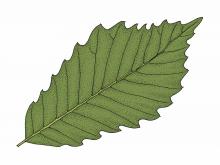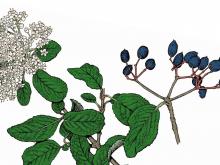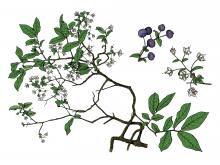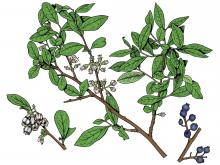Trees, Shrubs and Woody Vines
Media

Species Types
Scientific Name
Quercus muehlenbergii
Description
Chinkapin oak is fairly easy to identify because of its distinctively toothed leaves. Look for it growing in rocky soils derived from limestone or dolomite on bluffs and in upland woods, and in floodplain forests and lower slopes along streams.
Media

Species Types
Scientific Name
Prunus serotina
Description
Black cherry is prized for its high-quality wood. With its rich red color, it is easy to machine and holds its shape well. Eastern tent caterpillars like black cherry as well, spinning “tents” or bags on the branches for protection while they feed on the leaves.
Media

Species Types
Scientific Name
Ceanothus americanus
Description
A very small shrub of our native prairies and other open sites, New Jersey tea was used by patriotic American colonists as a substitute for black tea imported from England during the Revolutionary War.
Media

Species Types
Scientific Name
Viburnum rufidulum
Description
Southern black haw is an irregularly branched shrub with shiny, dark green, opposite leaves whose lower surface is paler with scattered rusty hairs, especially on the veins. It bears clusters of white flowers, which turn into bluish-black fruits.
Media

Species Types
Scientific Name
Vaccinium stamineum
Description
Deerberry is an irregularly branched shrub, rarely more than 6 feet high. A blueberry relative, it bears edible blue fruits.
Media

Species Types
Scientific Name
Vaccinium pallidum (syn. V. vacillans)
Description
Lowbush blueberry is a stiffly branching shrub to 3 feet high. The berries are tasty raw or cooked in pies, muffins, and preserves. It is mostly found south of the Missouri River. It often grows in extensive colonies.
Media

Species Types
Scientific Name
Vaccinium arboreum
Description
Farkleberry, or sparkleberry, is a stiff-branched shrub or small crooked tree growing in loose thickets on rocky soils, mostly south of the Missouri River. A type of blueberry, its black fruits are edible but dry and mealy.
Media

Species Types
Scientific Name
Rubus occidentalis
Description
Black raspberries resemble blackberries, but when ripe, the fruits fall away as a caplike unit from the receptacle. Leaflets appear white underneath. The canes are whitish-coated when young; they arch down and take root at the tips. Native and scattered statewide.
See Also
About Trees, Shrubs and Woody Vines in Missouri
There are no sharp dividing lines between trees, shrubs, and woody vines, or even between woody and nonwoody plants. “Wood” is a type of tissue made of cellulose and lignin that many plants develop as they mature — whether they are “woody” or not. Trees are woody plants over 13 feet tall with a single trunk. Shrubs are less than 13 feet tall, with multiple stems. Vines require support or else sprawl over the ground.





















